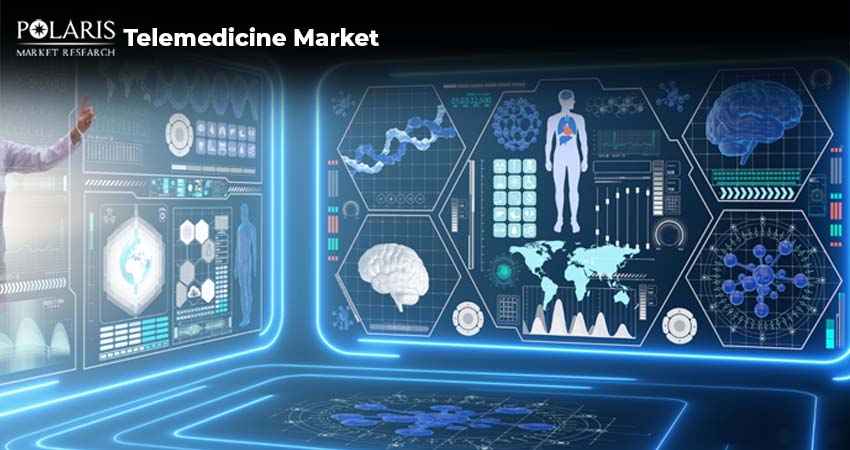Identifying Top 20 Players Influencing Telemedicine Market Dynamics in 2025

The healthcare landscape is undergoing a seismic shift, and telemedicine is at the forefront of this transformation. By leveraging technology to deliver medical care remotely, telemedicine has bridged geographical gaps, brought healthcare to underserved populations, and redefined patient convenience. This groundbreaking innovation, fueled by advancements in digital communication and AI, allows patients to consult doctors, receive diagnoses, and even access treatments from the comfort of their homes.
The COVID-19 pandemic accelerated the adoption of telemedicine, making it an essential part of modern healthcare systems. In this blog, we explore the evolution of telemedicine, its benefits, challenges, and the top companies shaping this growing sector.
What Exactly Is Telemedicine?
Telemedicine refers to the practice of delivering healthcare services remotely using electronic information and communication technologies, allowing patients to consult with doctors or other healthcare providers via video calls, phone consultations, or other digital platforms without needing to physically visit a clinic, essentially bridging the distance gap in healthcare delivery. Patients can connect with their healthcare provider through a secure online platform, usually using a computer, 5G smartphone or tablet, to discuss their health concerns, receive diagnoses, and get treatment plans.
Benefits of Telemedicine
- Accessibility & Convenience
Telemedicine eliminates the need for patients to travel long distances to access healthcare. This is particularly beneficial for individuals in rural or underserved areas, where healthcare facilities are often scarce.
- Cost Effectiveness
Virtual consultations significantly reduce costs associated with in-person visits, including transportation and time away from work. It also decreases the burden on healthcare infrastructure.
- Enhanced Patient Monitoring
Remote monitoring tools allow doctors to keep a close eye on patients' health metrics, enabling early intervention and better disease management.
- Better Chronic Care Management
For patients with chronic conditions, telemedicine provides regular check-ins, medication reminders, and access to health data, enhancing their quality of life.
Major Companies in Telemedicine
Teladoc Health was founded in 2002 in Dallas, Texas, USA. The company’s main headquarters are located in Purchase, New York, USA. Teladoc Health is a global leader in telemedicine, offering virtual healthcare services across more than 175 countries. Its platform provides 24/7 access to doctors, mental health professionals, and nutritionists, making it a one-stop solution for various healthcare needs.
- Amwell
Headquartered in Boston, Massachusetts, USA, Amwell was founded in 2006. Amwell is a healthcare company that uses technology, services, and devices to improve patient access and the clinician experience. Amwell specializes in connecting patients with healthcare providers through its user-friendly telemedicine platform. It offers services ranging from urgent care to behavioral health, partnering with hospitals and insurance companies to expand access to care.
- Practo
Practo, an India-based telemedicine company, connects patients with healthcare professionals and offers services like online consultations, medicine delivery, and diagnostic tests. Practo was founded in 2008 and is headquartered in Bangalore, Karnataka, India. Practo started as a healthcare practice management software company. It has become a go-to platform for comprehensive healthcare needs in the region.
Doctor on Demand is a privately held company that provides you with 24/7 customer support. Headquartered in San Francisco, California, USA, it was established in 2013. Focused on providing affordable and accessible healthcare, Doctor on Demand offers video consultations for urgent care, mental health, and preventive health. The platform collaborates with major employers and health plans to improve healthcare accessibility.
- Ping An Good Doctor
Ping An Good Doctor was founded in June 2014 and is a subsidiary of Ping An Insurance. Its main headquarters are based in Shanghai, China. Ping An Good Doctor is an online-to-offline (O2O) healthcare platform that offers personalized medical and health management services. Its AI-powered platform serves millions of users daily. Ping An Good Doctor's services include health management, disease management, chronic illness management, and eldercare management.
Emerging Trends in Telemedicine
The telemedicine market is constantly evolving, with new trends shaping its future. A few of them are discussed below.
AI-Driven Diagnostics
Artificial intelligence (AI) is enhancing diagnostic accuracy and enabling faster, more efficient consultations by analyzing symptoms and patient history.
5G Connectivity
The rollout of 5G networks is set to revolutionize telemedicine by enabling high-quality video consultations and seamless data transfer, even in remote areas.
Blockchain for Data Security
Blockchain technology is being explored to improve the security and transparency of telemedicine platforms, addressing concerns about patient data privacy.
Virtual Reality (VR) in Therapy
VR is being used in teletherapy and rehabilitation programs, offering immersive experiences for mental health and physical recovery.
Wearable Technology Integration
Wearable medical devices like smartwatches and fitness trackers are becoming essential tools for remote monitoring, providing real-time health data. They play an important role in the telemedicine market.
Challenges in Telemedicine
Despite having numerous advantages, telemedicine industries face several challenges.
- Data Privacy and Security
Protecting sensitive patient information from cyber threats is a critical concern in the telemedicine industry.
- Technological Accessibility
Limited internet connectivity and lack of digital literacy in certain regions of the world are harming the adoption of telemedicine companies.
- Regulatory and Licensing Issues
Different telemedicine laws and licensing requirements across states and countries complicate implementation fairly in the market.
- Limited Physical Examination
Certain medical conditions require in-person examination, which telemedicine cannot replicate entirely as it is required.
Conclusion
Telemedicine is not just a trend. It is a revolution that is reshaping healthcare delivery. As the healthcare industry expands, telemedicine will likely become a cornerstone of modern healthcare systems, integrating seamlessly with traditional care models. Governments and healthcare organizations are investing heavily in telehealth infrastructure, recognizing its potential to address systemic challenges and improve patient outcomes. With advancements in technology, the scope of telemedicine is expected to broaden further, encompassing specialized fields like tele-surgery and personalized medicine.

